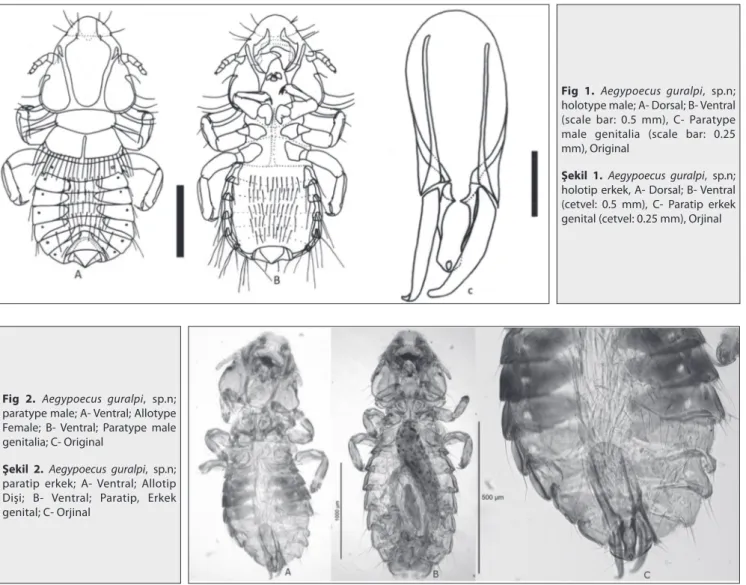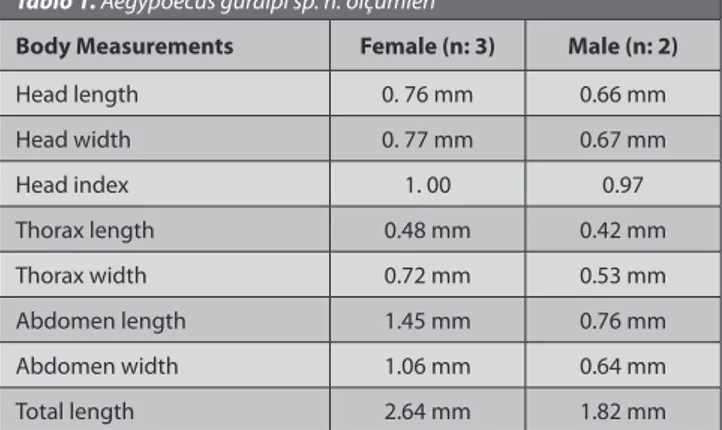Abstract
A total of ten louse samples were collected from a long-legged buzzard (Buteo rufinus) in Hatay province in Mediterranean Region of Turkey. All of the louse samples were identified as a new species morphologically and named as Aegypoecus guralpi.
Keywords: Aegypoecus guralpi, Louse, Long-legged buzzard
Kızıl Şahin (Buteo rufinus)’de Yeni Bir Bit Türü: Aegypoecus guralpi
sp. n. (Phthiraptera: Ischnocera)
Özet
Türkiye’nin Akdeniz Bölgesi’nde yer alan Hatay ilinde bir kızıl şahinden (Buteo rufinus) toplanan 10 adet bit örneği morfolojik olarak incelenmiş, örneklerin tamamı yeni bit türü olarak teşhis edilmiş ve Aegypoecus guralpi adıyla isimlendirilmiştir.
Anahtar sözcükler: Aegypoecus guralpi, Bit, Kızıl şahin
A New Louse Species: Aegypoecus guralpi sp. n. (Phthiraptera:
Ischnocera) from a Long-legged Buzzard (Buteo rufinus)
[1]Bilal DİK
1 Mustafa Necati MUZ
2Turgay ÜSTÜNER
3[1] 1 2 3
This study was presented at the 5th International Conference on Phthiraptera (2-7 August, 2014, Park City, Utah, USA)
University of Selçuk, Faculty of Veterinary Medicine, Department of Parasitology, TR-42250 Konya - TURKEY
University of Namik Kemal, Faculty of Veterinary Medicine, Department of Parasitology, TR-59030 Tekirdağ - TURKEY University of Selçuk, Science Faculty, Department of Biology, Program of Zoology, TR-42250 Konya - TURKEY
INTRODUCTION
The Aegypoecus genus was generated by Clay and Meinertzhagen [1] as Helluo from Aeygpiinae. Round-bodied
louse species of vultures have adapted to live on head and neck niches [2,3]. There are a few lice species reported
in the genus Aegypoecus. In 1838, Burmeister described Docophorus brevicollis, Kellogg [4] identified Aegypoecus
(Docophorus) perspicuous from Corvus spp.. Aegypoecus neophron (Helluo neophron) was reported from Neophron percnopterus by Clay and Meinertzhagen [1]. Ansari [5] reported
A. brevicollis from Aegypius monachus and Aegypoecus perspicuus (Kellogg, 1914) (as Aegypoecus griffoneae) from Gyps himalayenesis Hume in Punjab, India. Dhanda [6]
recorded a new species, as Aegypoecus hopkinsi from Necrosyrtes monachus. Pérez-Jiménez et al.[2] later renamed
it as A. brevicollis. In the current study, a new louse species for this genus has been morphologically identified in all collected samples from a long-legged buzzard (Buteo rufinus) in Hatay province in Mediterranean Region of Turkey.
MATERIAL and METHODS
A total of ten louse samples were collected from a long-legged buzzard (Buteo rufinus) in Hatay (Batiayaz district, 36° 16′ N, 35° 99′ E) in Mediterranean Region of Turkey along the Syria border in 2012. The lice were stored in ethanol 70% and cleared in KOH 10% for 24 h. The lice were slide-mounted in Canada balsam and kept in an incubator for 20 days to dry. The louse samples were individually examined using phase contrast microscope (Leica DM 750) morphologically and identified at a species level. The new louse species described here was deposited in the collection at the Department of Parasitology, Faculty of Veterinary Medicine, University of Selcuk, Konya, Turkey.
RESULTS
All of the ten louse samples were identified as a new species Aegypoecus sp. and named as Aegypoecus guralpi
İletişim (Correspondence)
+90 332 2232736
bdik2004@yahoo.comKafKas Universitesi veteriner faKUltesi Dergisi JoUrnal Home-Page: http://vetdergi.kafkas.edu.tr
online sUbmission: http://vetdergikafkas.org
Short Communication
Kafkas Univ Vet Fak Derg 21 (6): 929-932, 2015
DOI: 10.9775/kvfd.2015.13867
930
A New Louse Species: Aegypoecus ...
in memory of Prof. Dr. Nevzat Guralp (deceased) who was well respected by the first author.
Aegypoecus guralpi sp.n. Type Host: Buteo rufinus
Male: (Holotype) Rather small, but head is very large, whereas thorax and abdomen are short (Fig. 1A, 1B; Fig. 2A). The triangular head is narrowed anteriorly. The length of the head is equal to the width. The anterior margin is slightly rounded and a marginal carina is interrupted by a hyaline membrane at the median. The clypeal plate is relatively broad, short and weakly developed, and also narrowed as a small prolongation to the posterior end. The ventral anterior plate is narrowed as a strip. The mandibles are large and very stout, and dark coloured in apical ends. The preantennal region is well developed in the lateral aspect. The length of the preantennal head region is subequal to the postantennal head region. The trabeculae are small and hypopharyngeal sclerite is well developed. The antenna have five segments, the first and second segments are wide and long, respectively. The preantennal and ocular setae are short. There are also five long marginal temporal setae in Fig. 1A, 1B.
The thorax is small, prothorax and pterothorax are quadrangular and rounded laterally, and the posterior margin is slightly convex. The pronotum has two long setae on each side of lateromarginal angles. The prosternal plate is small and pentagonal shaped, pointed at the anterior, without setae. It is pteronotum in almost all parts, except a little anterior part that is fully divided as a narrow strip at the median. The anterior part of this line is of a width wider than the posterior part with 11-12 long setae on the each side of the posterior margin.
The abdomen is very short, relatively broad and rounded. Pleural plates are present, narrowed and well developed. Paratergal plates are slightly well-developed, paratergal plates of segment II-IV are dark and distinct in paratype, narrowed and rounded at the median, and also equal in segments II-VII (well developed in paratype). There are two irregular rows of tergocental setae on the posterior margin of the abdominal segments.
Genitalia is displayed in Fig. 1C; Fig. 2C. Male genitalia was drawn from the paratype male due to it was not clear in holotype. It was also take the photos of paratype of male due to it was more clear than holotype male. The basal plate
Fig 1. Aegypoecus guralpi, sp.n;
holotype male; A- Dorsal; B- Ventral (scale bar: 0.5 mm), C- Paratype male genitalia (scale bar: 0.25 mm), Original
Şekil 1. Aegypoecus guralpi, sp.n;
holotip erkek, A- Dorsal; B- Ventral (cetvel: 0.5 mm), C- Paratip erkek genital (cetvel: 0.25 mm), Orjinal
Fig 2. Aegypoecus guralpi, sp.n;
paratype male; A- Ventral; Allotype Female; B- Ventral; Paratype male genitalia; C- Original
Şekil 2. Aegypoecus guralpi, sp.n;
paratip erkek; A- Ventral; Allotip Dişi; B- Ventral; Paratip, Erkek genital; C- Orjinal
931 DİK, MUZ, ÜSTÜNER
is relatively short, rounded anteriorly, and reaches to the posterior part of segment V. Parameres are well developed. Female: Similar to the male, but longer (Table 1). The abdomen is short, relatively broad, rounded and slightly longer than the total length of the head and thorax. Segment IX is bilobed. The genital plate is large and distinct. There is no lanceolate hair on abdominal segments (Fig. 2B; Fig. 3).
Abdominal chaetotaxy: Tergocentral setae numbers in posterior margin: II, 15; III, 15; IV, 15; V, 13; VI, 10; VII, 8; VIII, 6. Sternit IX has a cluster with 16 setae on the lateral margins. Short post-spiracular setae do not reach to the anterior part of next segment.
DISCUSSION
Natural louse infestations of vultures caused by
the genus Aegypoecus are rarely reported. Only seven species of Aegypoecus; A. brevicollis (Burmeister, 1838); A. trigonoceps (Giebel, 1874); A. perspicuus (Kellogg, 1914); A. hopkinsi (Dhanda, 1959); A. clayae (Dhanda, 1960); A. jordani (Dhanda, 1960); and A. africanus Dhanda, 1960, have been described until now.
The specimens in this report were similar with Clay’s description [1]. Clay described large heads, short broad
abdomens, short ventral trabeculae protruding beyond the lateral margin of the head, widely-separated tergal plates, and numerous dorsal and ventral lanceolate-like hairs for the Aegypoecus (Helluo) species. Clay also emphasized that the abdomen of females had three, small, irregular shaped dark chitinious plates in the centre of segment VII; one was flanked median by a lateral plate on each side, and the terminal segment was bilobed and rounded posteriorly in the male. This study identified two clear descriptive differences: (i) no lanceolate-like hairs were found on the abdominal segments of the louse specimens and (ii) two dark and large chitinous plates were found at the terminal abdominal segments of the female.
Dhanda [6] stated that the Aegypoecus species
parasitized on vultures had four, long marginal temporal setae, and even if a fifth one was present, it was short and spine-like. Dhanda [6] also reported that a long seta
was found on each side of the prothorax in the genus Aegypoecus. Our specimens have two relatively short setae at the posterolateral margins of the prothorax. The specimens have five long marginal temporal setae, two prothorasic setae and no lanceolate hairs on the abdominal segments. The results of morphological evidence from the lice collected on a non-vulture host indicate that these specimens are different from the other species in the genus Aegypoecus. This species may be considered as a “straggle” for B. rufinus. Because all lice species were described under the genus Aegypoecus found on Vulturidae, Buteo rufinus may be accepted as a natural host for this new louse species. Indeed there are few studies about louse species of the wild birds in Turkey although on intercontinental route of migratory birds [7-10].
REFERENCES
1. Clay T, Meinertzhagen R: New genera and species of Mallophaga.
Entomol, 71, 275-279, 1938.
2. Dhanda V: A new species of Aegypoecus Clay and Meinertzhagen,
1939 (Mallophaga). Ann Mag Nat Hist, 2, 725-730, 1960. DOI: 10.1080 /00222935908655759
3. Pérez-Jiménez JM, Soler-Cruz MD, Ruiz-Martínez I, Díaz-Lopez M, Granados-Torres JE: A redescription of Aegypoecus brevicollis (Burmeister,
1838) (Ischnocera: Philopteridae). Sys Parasitol, 22, 215-219, 1992. DOI: 10.1007/BF00009668
4. Kellogg VL: Mallophaga from birds of the South Atlantic. Sci Bull Mus
Brook Inst Art Sci, 2, 80-89, 1914.
5. Ansari AR: Mallophaga (Ischnocera) infesting birds in the Punjab
(India). Proc Nat Inst Sci India, 13, 253-303, 1947.
6. Dhanda V: A revision of the Mallophagan genus Aegypoecus Clay Fig 3. Aegypoecus guralpi, sp.n; Allotype female; A- Dorsal; B- Ventral
(scale bar: 0.5 mm)
Şekil 3. Aegypoecus guralpi, sp.n; Allotip Dişi; A- Dorsal; B- Ventral
(cetvel: 0.5 mm)
Table 1. Measurements of Aegypoecus guralpi sp. n. Tablo 1. Aegypoecus guralpi sp. n. ölçümleri
Body Measurements Female (n: 3) Male (n: 2)
Head length 0. 76 mm 0.66 mm Head width 0. 77 mm 0.67 mm Head index 1. 00 0.97 Thorax length 0.48 mm 0.42 mm Thorax width 0.72 mm 0.53 mm Abdomen length 1.45 mm 0.76 mm Abdomen width 1.06 mm 0.64 mm Total length 2.64 mm 1.82 mm
932
A New Louse Species: Aegypoecus ...
and Meinertzhagen, 1939 (Ischnocera: Philopteridae), with descriptions of three new species. Ann Mag Nat Hist, 13, 657-683, 1961. DOI: 10.1080/00222936008651072
7. Dik B, Yamaç E, Uslu U: Chewing lice (Phthiraptera) found on wild
birds in Turkey. Kafkas Univ Vet Fak Derg, 17, 787-794, 2011. DOI: 10.9775/ kvfd.2011.4469
8. Goz Y, Dik B, Kılınç Ö, Yılmaz A, Aslan L: Chewing lice (Phthiraptera:
Amblycera, Ischnocera) on several species of wild Birds around the Lake
Van basin, Van, Eastern Turkey. Kafkas Univ Vet Fak Derg, 21, 333-338, 2015. DOI: 10.9775/kvfd.2014.12484
9. Dik B, Yamaç E, Uslu U: Studies on Chewing Lice (Phthiraptera:
Amblycera, Ischnocera) Species from Domestic and Wild Birds in Turkey.
Kafkas Univ Vet Fak Derg, 19, 553-560, 2013. DOI: 10.9775/kvfd.2012.8207
10. Girisgin AO, Dik B, Girisgin O: Chewing lice (Phthiraptera) species of
wild birds in northwestern Turkey with a new host record. Int J Parasitol

